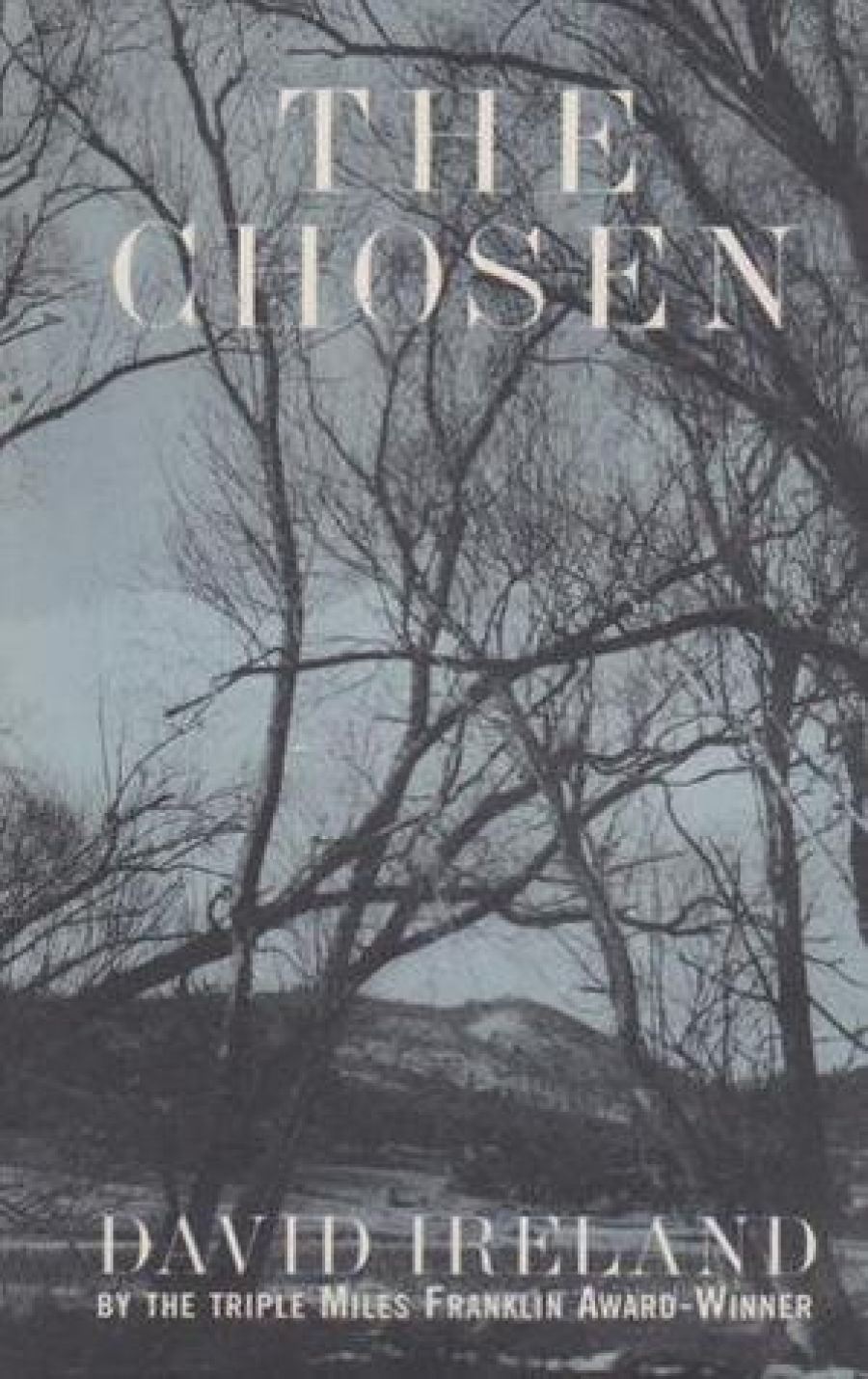
- Free Article: No
- Contents Category: Fiction
- Review Article: Yes
- Online Only: No
- Custom Highlight Text:
Like much else about this novel, its title The Chosen is not the relatively straightforward affair it may, at first, appear to be. One assumes for the first hundred pages or so that the ‘chosen’ are those citizens of the small NSW Southern Tablelands town of Lost River who have been chosen by a randomising computer program to have their lives represented in the commemorative tapestry being woven as a civic project along with two other pet Town Council proposals, a new jail and a high-temperature incinerator. It’s a mode that critic Ken Gelder has called ‘dark pastoral’.
But the narrator and central character of this book, the weaver Davis Blood, is the same Davis Blood from Bellbird Corner who was at the centre of David Ireland’s last novel Bloodfather ten years ago; and Bloodfather was Ireland’s Künstlerroman, his Portrait of the Artist as a Young Whatever. Like Bloodfather, The Chosen involves a Romantic representation of the artist-figure as an isolated· creature at once tormented and beatified, somebody fingered by the fates – these being personified here by Lost River’s city fathers – to represent humanity to itself in art. Chosen, that is to say.
Fifty-two Lost River citizens figure in the tapestry, one for each week of the year; Davis Blood is given exactly a year to finish it. The Chosen, unlike Ireland’s usual ‘atomised’ narrative structures, is evenly divided into fifty-six chapters; there’s one for each citizen plus a couple of framing chapters at the beginning and at the end which call the entire middle into question: look, for example, at the dates on which the story begins and ends, and what of the tiny and mysterious clean white cotton sock? (Just the one.) This is no more a realist fiction than most of Ireland’s other work, more a surreal allegory about – among other things – the relationship between art and community.
The weaver interviews the chosen citizens and tells each story in turn. At the end of each story he returns briefly to his own inner preoccupations: his guilt about past unspecified crimes (callousness? violence? original sin?), and his memories of a now-absent woman called Yarrow, his muse and unrequited love, a black-clad theory-junkie with a stern turn of phrase and with whom, in her absence, he argues ferociously. Yarrow seems to represent in turn the Eternal Feminine, the DIY Feminist, and the Theory without which practice cannot proceed; we only discover near the end that she has at some unspecified time been fatally knocked off her bike on the way to the library.
The cast of voices gives Ireland unlimited freedom to range across issues of late-twentieth-century life in Australia and elsewhere: various characters are preoccupied with education, marriage, crime prevention, women’s rights, government policies, or the theory and practice of art, and – as in a tapestry – these different sections speak against, to, and across each other. The fifty-two citizens are a philosophical lot; meditation, exposition and polemic abound, and it’s impossible to tell which, if any, bits directly represent the views of Ireland himself.
One recurrent strain, however, is recognisable as a longstanding Ireland preoccupation; several of the citizens dwell on the powerlessness and helplessness of individuals in the face of companies, bureaucracies, and governments, specifically the ‘feral government’ in ‘Canburrow’. One of the fifty-two citizens ‘began to be resentful, then angry, when he had to deal with official bodies that operate on the principle that society is a creation of government, rather than the other way round.’ Several of them, like Adora Wheller (‘Named after a biscuit’), are sharply original thinkers: ‘Other women seem to find work romantic, as if what men have always done must be interesting. Is it a con trick? … Will I get like men, satisfied with discomfort and subordination all my life?’
Like earlier Ireland novels this one is not for the squeamish, abounding as it does in surreal and nightmarish imagery and metaphor frequently involving bodily horrors and hints of violent rupture: the needle murder, the cannibal rapist, the medical student who calmly dissects the preserved and bisected head of her dead auntie. Pastoral in setting this book may be, but there’s no hint that Ireland regards or wishes to represent the rural life as morally superior. ‘Humanity is fully consistent with cruelty,’ remarks one character with conviction.
Ireland has such a black imagination that it’s easy to forget how funny he is. A number of these fifty-two voices utter what are essentially stand-up comedy routines; others are funny without meaning to be. ‘I don’t like jokes about lovemaking’, one says solemnly, ‘or people who blow when you say suck’. Then there’s the teacher trying to keep her neuroses under control: ‘At least I’m not like my mother who was terrified of wandering interplanetary sperm.’ Much of the funny stuff is gentle comedy about animals, like the imaginary animals that people Davis Blood’s imagination: the Snowy River armadillo chicken, the Yoogali sideways hare, the Windy Flats approximation bird, the Spotted River panic fish and the Reid’s Flat rock-chewing dog, just to name a few. There’s also a virtuoso chapter devoted to the only non-human creature represented in the tapestry, a philosophical and dignified cat. If you can stomach the vintage Ireland nightmare stuff, like the thoughts of the cannibal rapist and the story of the Baby Face Gang, and if you remain undisquieted by his destabilising world view, this book is a great pleasure to read.


Comments powered by CComment